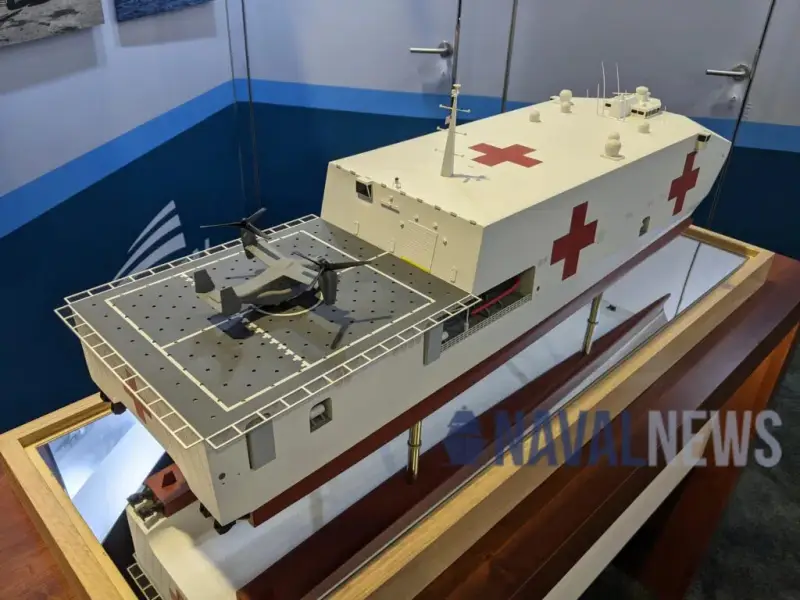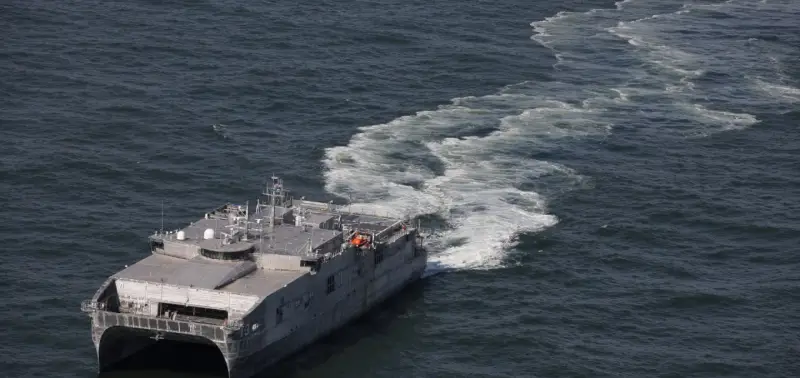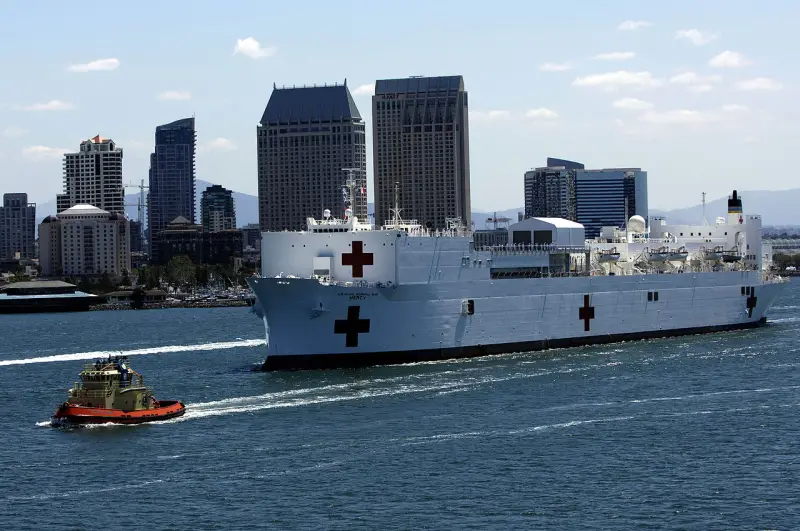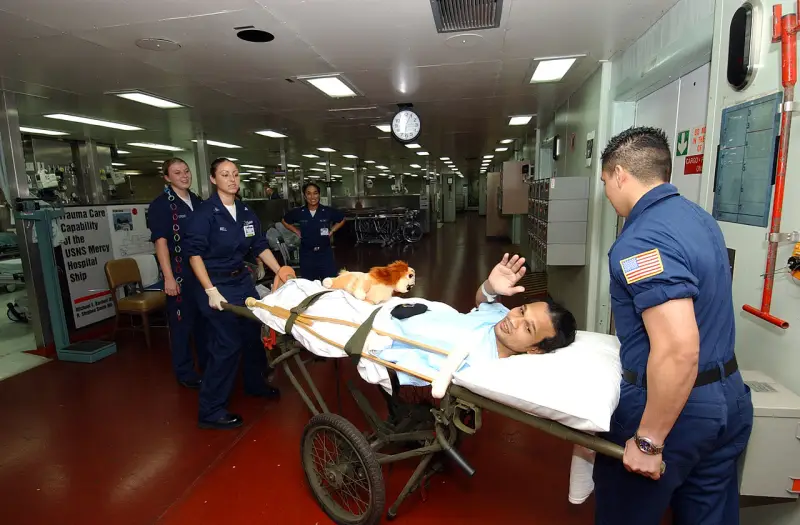EMS hospital ships for the US Navy

Design appearance of the EMS vessel in the 2023 version. Graphics by Austal USA
The US Navy is planning to build and commission three new hospital ships. They will be carried out under the new Expeditionary Medical Ship (EMS) project, the development of which is now being completed by Austal USA. In order to speed up design, simplify construction and achieve maximum performance, the floating hospital is based on the EPF high-speed expeditionary transport catamaran design.
Continuity of projects
In 2010, the American branch of Austal, having received the corresponding contract from the US Navy, laid down the lead transport of the EPF type - USNS Spearhead (T-EPF-1). It was handed over to the customer at the end of 2012, and then the construction of catamarans continued. A few days ago, the fleet received the 14th vessel of this type, and two more are expected.
The EPF vessel was considered as a platform for placing certain assets and loads. In particular, at the end of the tenth years, Austal USA developed the appearance of a hospital ship based on the Spearhead under the designation EMS. In 2021, the premiere of this project took place at one of the American exhibitions. A model of a floating hospital was shown and its main features and characteristics were revealed.
In early 2023, the Navy announced that the EMS project would advance to construction. The current military budget provided for funding for the construction of three such pennants, and the signing of a corresponding contract was expected in the near future. Before this, in May and October, the names of the first two ships of the project were announced. The third remains unnamed for now.

Model of the EMS vessel arr. 2021 Photo by Naval News
According to reports, the original EMS design from Austal USA did not suit the customer, and he made his own proposals affecting the design and equipment of the vessel. In November 2023, the development company showed an updated version of the hospital ship, which differed in different dimensions, hull shape, layout, etc. Apparently, the Pentagon was completely satisfied with this version of the project.
On December 22, the US Navy awarded Austal USA a contract to continue work on the EMS project. The contractor will have to complete the development of the project, as well as build, test and deliver three new vessels to the customer. The total cost of the work is estimated at $867,6 million. The timing of the various stages and completion of the program as a whole has not yet been specified, and the parties are making do with only the most general formulations.
Despite the lack of details, the Navy and Austal USA did not forget to highly appreciate the new project and note its great importance for further development fleet, improving the expeditionary potential of the armed forces, etc. How objective such assessments are and whether the current optimism is justified is unknown. This issue will become clear only in a few years.
In the middle term
The customer and the contractor revealed the most basic plans, and the available information allows us to present an approximate work schedule. In general, they are not going to rush, and new ships will enter service only in the medium term. However, the current state of the medical fleet allows the Pentagon not to rush.

Transport vessel USNS Apalachicola (EPF 13). Photo by Austal USA
It is reported that for the near future, the main task of Austal USA remains the construction of 16 previously ordered EPF Spearhead transports. 14 vessels of this type have already been delivered to the customer, and another one is under construction from June 2023. The keel of the last hull is expected this year. The construction of Spearheads takes about one and a half to two years, and only one ship is on the slipway at a time. Accordingly, the series will be completed in 2025-26.
Thus, the development company has about two more years to complete the design of the EMS hospital ship, prepare for construction, conclude the necessary contracts for special equipment, etc. The slipway for the head EMS will only be released in 2025, and then its laying should be expected.
The first ship of the EMS project was named Bethesda - in honor of the city in the state. Maryland, home of the National Military Medical Center. Walter Reed. The vessel was also assigned the tactical number T-EMS-1. The second ship, T-EMS-2, is named Balboa, after the park in San Diego where the Military Medical Center operates. The name for the third vessel has not yet been chosen, but it is obvious that it will also be associated with one of the key US military medical institutions.
EMS hospital ships will be larger than Spearhead transports and will have more sophisticated equipment. Accordingly, their construction will take more time - probably at least two to three years. In this case, the lead ship Bethesda will enter service no earlier than 2028, and Balboa will be handed over to the customer only by 2030. However, it cannot be ruled out that the construction will not be so complicated, and the entire series of three ships will enter service by the end of the decade.

Hospital ship USNS Mercy (T-AH-19). Photo by US Department of Defense
Technical features
The EMS project is created on the basis of the existing EPF, but is noticeably different from it. At the customer's request, the body was enlarged and redesigned, its internal equipment was changed, etc. At the same time, the general architecture and design characteristics generally remained the same. Probably, the appearance of the vessel, presented last fall, is final, although one or another minor changes cannot be ruled out.
EMS type vessels will be catamarans with a total length of 110 m and a width of 30,5 m; draft - 4,6 m. The general architecture with a wide bridge, which actually serves as a superstructure and accommodates all the main volumes and premises, is preserved. At the same time, in comparison with EPF, the shape of the nose has been changed. To improve hydrodynamic characteristics, the stems of the two hulls are tilted back.
The development company has not yet announced the displacement of the promising vessel. Judging by the increase in size, the EMS hospital will be heavier than the EPF transport, whose displacement exceeds 1500 tons.
EPF vessels have a power plant based on four MTU 20V8000 M71L diesel engines and ZF 60000NR2H gearboxes. It is likely that the EMS project uses similar solutions and components. With their help, the ship will be able to reach speeds of more than 30 knots. The economic speed will be half that and will provide a cruising range of 5 thousand nautical miles.
The hull and superstructure of the vessel are built to obtain the maximum possible volume, which is used to accommodate the crew and patients. Thus, in the cabins and cockpits there are 185 places for the ship’s own crew, flight personnel and medical personnel. The accommodation of personnel meets all requirements.

Transporting a bedridden patient inside the USNS Mercy (T-AH-19). Photo by US Department of Defense
The floating hospital will have 124 beds to accommodate patients with various injuries, diseases, etc. There are four operating rooms, an intensive care unit with 20 beds, incl. 6 in an isolation ward, a 40-bed emergency department with a 6-bed isolation ward, etc.
Using a platform in the form of EPF transport will simplify the loading and delivery of patients. People and equipment will be able to get on board the vessel through the ports on the sides. In the aft part, as in the basic design, a folding ladder with high lifting capacity is provided. There is also a platform for a helicopter or tiltrotor at the stern of the vessel.
New generation
Currently, the US Navy has only two Mercy-class hospital ships. These are vessels of traditional design with a length of approx. 270 m with a displacement of more than 70 thousand tons, carrying more than a thousand beds each. In the foreseeable future, they will be supplemented by three new ships of the new EMS project. The new pennants will be smaller in size and will be able to take several times fewer patients on board.
However, the Navy felt that these were the hospital ships they needed. It is expected that the new EMS will be able to arrive at the job site and begin providing assistance more quickly. In addition, ships of smaller size and displacement will be less demanding of the water areas and ports in which they will operate. At the same time, they will receive the most modern equipment, which will also provide certain advantages.
Thus, as a result of the EMS program, in the next 5-10 years, the US Navy hospital fleet will change in a very serious way, both quantitatively and qualitatively. It will be possible to respond to challenges faster and more flexibly, as well as work in different areas and conditions. However, all new opportunities will appear only in a few years, but for now it is necessary to complete the design and prepare for production.
Information